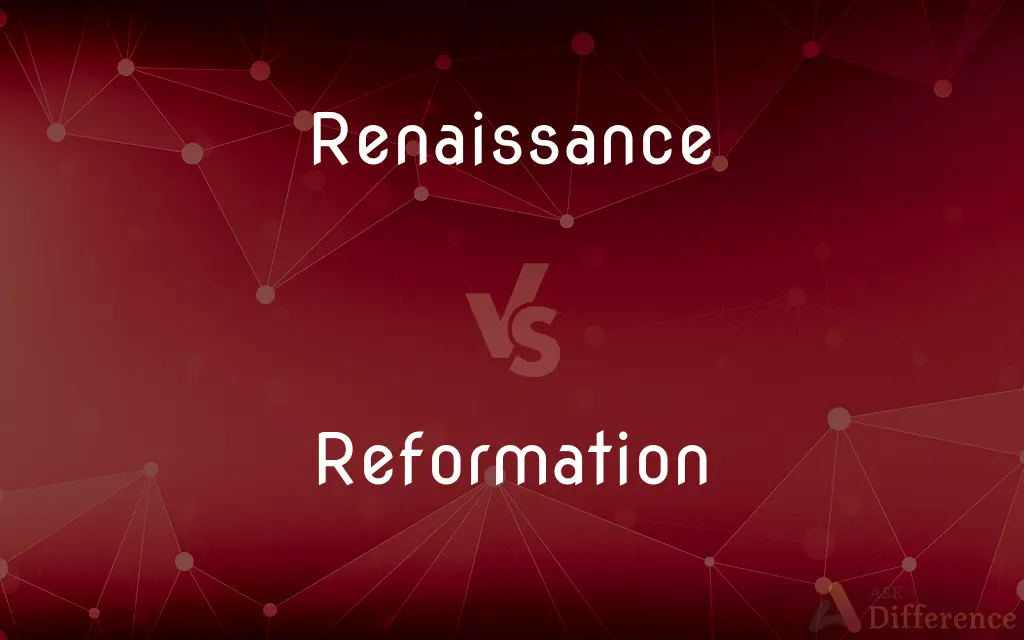Renaissance vs. Reformation — What's the Difference?
By Fiza Rafique & Maham Liaqat — Updated on March 20, 2024
Renaissance was cultural and intellectual movement focused on art, literature, and learning, rooted in a rediscovery of classical ideals. Reformation was religious movement aimed at reforming practices and beliefs of the Catholic Church.

Difference Between Renaissance and Reformation
Table of Contents
ADVERTISEMENT
Key Differences
The Renaissance, spanning roughly from the 14th to the 17th century, was a period of significant cultural and intellectual growth in Europe, marking a renewed interest in the classical art, literature, and philosophy of ancient Greece and Rome. It emphasized humanism, the study of classical texts, and the development of linear perspective in art. Conversely, the Reformation, which began in the early 16th century, was primarily a religious movement initiated by figures like Martin Luther and John Calvin. It sought to address and reform the perceived abuses and doctrinal issues within the Catholic Church, ultimately leading to the creation of Protestant churches.
Renaissance thinkers like Leonardo da Vinci and Michelangelo focused on human potential and achievements, fostering advancements in various fields such as art, science, and architecture. This contrasted with the Reformation, which concentrated on spiritual and ecclesiastical reforms, challenging the authority of the Pope and the Catholic Church's practices, including the sale of indulgences.
While the Renaissance had a broad cultural and intellectual scope, influencing numerous aspects of society, the Reformation was more focused on religious aspects. It not only altered the religious landscape of Europe, creating a division between Catholics and Protestants, but also had profound social and political implications. The Reformation led to conflicts such as the Wars of Religion in France and the Thirty Years' War in the Holy Roman Empire.
Both movements reflected a spirit of questioning and re-evaluation of traditional views and authorities. The Renaissance questioned the medieval worldview, placing a greater emphasis on the individual, while the Reformation challenged the central religious authority of the time. Despite their different focuses, both contributed to shaping modern European thought and society.
The Renaissance contributed to the weakening of the Catholic Church's influence by encouraging a secular worldview and individualism. This cultural shift provided a fertile ground for the Reformation, which directly challenged the Church's religious authority. Thus, while distinct, the Renaissance and Reformation are interconnected, with the former setting the stage for the latter's religious and societal reforms.
ADVERTISEMENT
Comparison Chart
Time Period
14th to 17th century
Early 16th century onwards
Focus
Cultural and intellectual revival
Religious reform
Key Figures
Leonardo da Vinci, Michelangelo, Raphael
Martin Luther, John Calvin, Henry VIII
Initiatives
Revival of classical texts, art, and humanism
Reform of church practices, theology
Impact
Advances in art, science, and philosophy
Split of Christianity, rise of Protestantism
Influence
Europe-wide cultural shift
Religious and political landscape change
Philosophical Basis
Humanism, individual achievement
Justification by faith, scriptural authority
Notable Works
"The Last Supper," "David," "School of Athens"
95 Theses, Institutes of the Christian Religion
Compare with Definitions
Renaissance
A cultural rebirth inspired by classical antiquity.
The Renaissance led to the creation of Michelangelo's David.
Reformation
A movement challenging Catholic Church's practices.
Luther's 95 Theses sparked widespread religious reform.
Renaissance
The Renaissance revolutionized artistic techniques.
The use of linear perspective in The Last Supper changed art history.
Reformation
The Reformation led to the establishment of Protestant churches.
Lutheranism and Calvinism became major Protestant branches.
Renaissance
The era produced masterpieces in literature and philosophy.
Shakespeare's plays reflect Renaissance themes of individuality and human nature.
Reformation
Religious conflicts stemming from the Reformation reshaped Europe.
The Thirty Years' War was a direct consequence of religious tensions.
Renaissance
Renaissance humanism emphasized the value of human achievements.
Da Vinci's Vitruvian Man symbolizes the era's humanist ideals.
Reformation
It emphasized personal faith and scripture's authority.
The translation of the Bible into vernacular languages made scriptures more accessible.
Renaissance
It fostered scientific inquiry and discovery.
Copernicus' heliocentric theory challenged traditional cosmology.
Reformation
The Reformation influenced governance and society.
The Peace of Westphalia in 1648 recognized the coexistence of Protestant and Catholic states.
Renaissance
The Renaissance (UK: rin-AY-sənss, US: (listen) REN-ə-sahnss) is a term used to describe a period in European history marking the transition from the Middle Ages to modernity and covering the 15th and 16th centuries. It occurred after the Crisis of the Late Middle Ages and was associated with great social change.
Reformation
The Protestant Reformation (alternatively and sometimes named the Protestant Revolution or European Reformation), was a major movement within Western Christianity in 16th-century Europe that posed a religious and political challenge to the Catholic Church, and in particular to papal authority, arising from what were perceived to be errors, abuses, and discrepancies by the Catholic Church. The Reformation was the start of Protestantism and the split of the Western Church into Protestantism and what is now the Catholic Church.
Renaissance
A rebirth or revival.
Reformation
The act of reforming or the state of being reformed.
Renaissance
The humanistic revival of classical art, architecture, literature, and learning that originated in Italy in the 14th century and later spread throughout Europe.
Reformation
Reformation A 16th-century movement in Western Europe that aimed at reforming some doctrines and practices of the Roman Catholic Church and resulted in the establishment of the Protestant churches.
Renaissance
The period of this revival, roughly the 14th through the 16th century, marking the transition from medieval to modern times.
Reformation
An improvement (or an intended improvement) in the existing form or condition of institutions or practices, etc.; intended to make a striking change for the better in social, political or religious affairs or in the conduct of persons or operation of organizations.
Renaissance
A revival of intellectual or artistic achievement and vigor:the Celtic Renaissance.
Reformation
(law) Change or correction, by a court in equity, to a written instrument to conform to the original intention of the parties.
Renaissance
The period of such a revival.
Reformation
The act of reforming, or the state of being reformed; change from worse to better; correction or amendment of life, manners, or of anything vicious or corrupt; as, the reformation of manners; reformation of the age; reformation of abuses.
Satire lashes vice into reformation.
Renaissance
Of, relating to, or characteristic of the Renaissance or its artistic and intellectual works and styles.
Reformation
Specifically (Eccl. Hist.), the important religious movement commenced by Luther early in the sixteenth century, which resulted in the formation of the various Protestant churches.
Renaissance
Of or being the style of architecture and decoration, based on classical models, that originated in Italy in the 14th century and continued throughout Europe up to the end of the 16th century.
Reformation
Improvement (or an intended improvement) in the existing form or condition of institutions or practices etc.; intended to make a striking change for the better in social or political or religious affairs
Renaissance
A rebirth or revival.
Reformation
A religious movement of the 16th century that began as an attempt to reform the Roman Catholic Church and resulted in the creation of Protestant churches
Renaissance
(historical) Renaissance
Reformation
Rescuing from error and returning to a rightful course;
The reclamation of delinquent children
Renaissance
A new birth, or revival.
The Renaissance was rather the last stage of the Middle Ages, emerging from ecclesiastical and feudal despotism, developing what was original in mediæval ideas by the light of classic arts and letters.
Renaissance
The period of European history at the close of the Middle Ages and the rise of the modern world; a cultural rebirth from the 14th through the middle of the 17th centuries
Renaissance
The revival of learning and culture
Common Curiosities
Can the effects of the Renaissance and Reformation still be felt today?
Absolutely, the Renaissance's contributions to art, science, and thought, along with the Reformation's impact on religious and political landscapes, continue to influence contemporary society.
What was the main goal of the Renaissance?
The Renaissance aimed to revive classical learning and art, celebrating human achievements and potential.
Were the Renaissance and Reformation opposed to each other?
Not directly; while the Renaissance was a cultural movement, the Reformation was religious. However, both challenged established norms and authorities in their respective domains.
How did the Reformation start?
The Reformation began with Martin Luther's critique of the Catholic Church's practices, notably the sale of indulgences, leading to wider religious reforms.
Did the Renaissance influence the Reformation?
Yes, the Renaissance's emphasis on individualism and critical inquiry helped pave the way for the questioning of religious authorities during the Reformation.
How did the Renaissance view the individual?
The Renaissance placed a high value on individual achievement and the potential for human greatness, a significant shift from the medieval worldview.
What role did technology play in both movements?
The printing press played a crucial role, spreading Renaissance humanist texts and Reformation writings, such as Luther's 95 Theses, thereby amplifying their impact.
Did the Renaissance and Reformation lead to conflict?
Yes, both led to conflicts: the Renaissance through its challenge to the medieval order and the Reformation through religious disputes, culminating in wars like the Thirty Years' War.
How did the Catholic Church respond to the Reformation?
The Catholic Church initiated the Counter-Reformation, enacting reforms and reaffirming its doctrines at the Council of Trent to address the criticisms and regain its followers.
What was the outcome of the Reformation?
The Reformation resulted in the permanent division of Christianity into Catholic and Protestant branches, significantly altering Europe's religious and political landscape.
Share Your Discovery

Previous Comparison
Seppuku vs. Kamikaze
Next Comparison
Plain vs. PlateauAuthor Spotlight
Written by
Fiza RafiqueFiza Rafique is a skilled content writer at AskDifference.com, where she meticulously refines and enhances written pieces. Drawing from her vast editorial expertise, Fiza ensures clarity, accuracy, and precision in every article. Passionate about language, she continually seeks to elevate the quality of content for readers worldwide.
Co-written by
Maham Liaqat














































